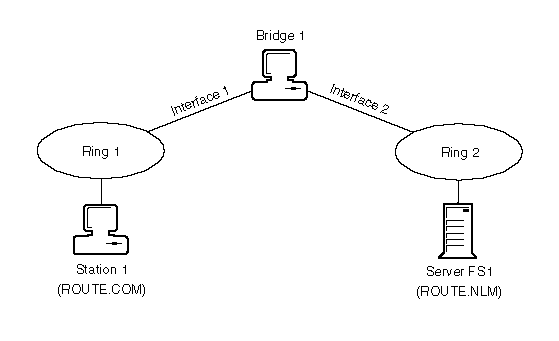ROUTE.COM and ROUTE.NLM in a Bridged Token Ring Network

For versions of Novell Internet Access Server 4.1 routing software and NetWare MultiProtocol RouterTM software that provide end station support for source route bridging, the configuration of ROUTE.NLM determines how the end station responds to explorer frames. Any machine that is running both Novell Internet Access Server 4.1 routing software and NetWare server software is acting as an end station. ROUTE.NLM must be loaded on any bridged interface that allows bridged clients to access the server, as well as on the bridged clients themselves.
Because the SRBRIDGE.LAN driver (used for logical boards) is also required when the system running Novell Internet Access Server 4.1 routing software provides print and file services for bridged clients, ROUTE.NLM is loaded automatically when a board using the SRBRIDGE.LAN driver is configured in the Novell Internet Access Server Configuration utility (NIASCFG). For physical boards, load ROUTE.NLM by setting the Source Route Status option to Enabled in NIASCFG (parameter path: Select Configure NIAS > Protocols and Routing > Protocols > Source Route End Station ).
Although the functionality of ROUTE.NLM can be configured on a per-interface (board) basis, we recommend that you use the default functionality. For more information about the options available for each ROUTE.NLM parameter using, refer to "Setting Up" in the routing documentation for Source Route Bridge.
Any client node that will be attaching to a bridged server must load ROUTE.COM, the file that provides client support, as shown in Figure 1.
By default, the source route client (ROUTE.COM) begins the route discovery process by originating a single-route explorer frame. ROUTE.COM can be configured to use all-routes explorer frames as well, but this can degrade network performance by creating more traffic on the network.
Figure 1
ROUTE.COM and ROUTE.NLM in a Bridged Token Ring Network
When a single-route explorer frame is sent by the client, it travels along a single-route (of forwarding interfaces) determined by the Spanning Tree Protocol. When this frame is received by the destination file server, the server responds with one of the following types of frames:
The most efficient response is a specifically routed frame. A specifically routed frame travels along the single route that was discovered by the explorer frame sent from the client. This is possible because all explorer frames sent from the source keep track of the ID numbers of all the bridges and rings they traversed to reach the destination node.
By default, the Novell source route server end station software responds to a single-route explorer frame with an all-routes explorer frame. Although you can configure your network to respond to an explorer frame with a specifically routed frame, we recommend that you use the default settings.
NOTE: Before the 1994 release of the source route server end station software, the defaults were different. In the earlier releases, the source route server software responded with a specifically routed explorer frame and could also be configured to respond to an explorer frame with an all-routes explorer frame. We recommend that you use matching versions of ROUTE.NLM and ROUTE.COM throughout your source route bridge topology to maintain a consistent mode of operation.
When the source receives responses from the destination, the source route end station software determines which one of the three criteria described on Which frame is received first (the fastest route) it uses to choose the best route. ROUTE.COM chooses the best route based on which frame is received first.
If the DEF (default) option is used, ROUTE.NLM responds in one of two ways:
When the destination responds with an all-routes explorer frame, the frame is propagated, as explained previously, and the (original) source receives one explorer frame for each route. Because each bridge encountered by the explorer frame records the bridge number and next ring number in the explorer frame's information field, each frame contains its own routing information. The fastest route is chosen.